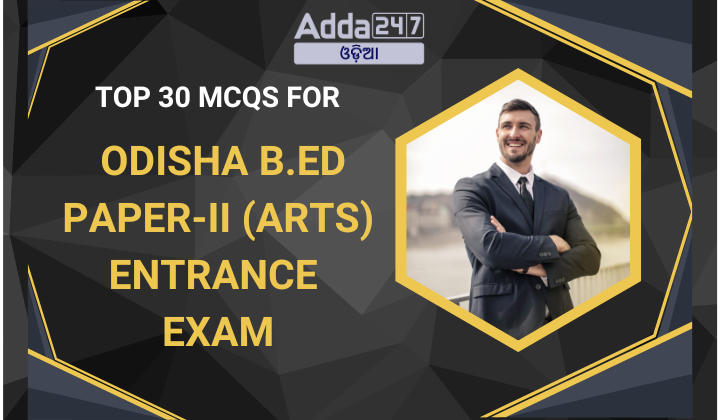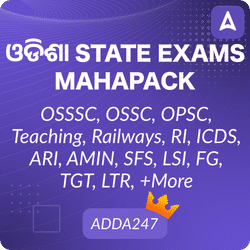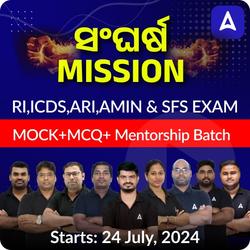Top 30 MCQs For Odisha B.Ed paper-II(Arts) Entrance Exam
- Who was the first Governor-General of Bengal?
(a) Robert Clive
(b) Warren Hastings
(c) Lord Cornwallis
(d) Lord Wellesley
Ans: (b) Warren Hastings - Which Act converted the post of Governor of Bengal into Governor-General of Bengal?
(a) Pitt’s India Act
(b) Regulating Act of 1773
(c) Charter Act of 1833
(d) Government of India Act of 1858
Ans: (b) Regulating Act of 1773 - Who introduced the Permanent Settlement of Bengal?
(a) Warren Hastings
(b) Lord Cornwallis
(c) Lord Wellesley
(d) Lord Minto I
Ans: (b) Lord Cornwallis - Which treaty was associated with the Third Mysore War?
(a) Treaty of Salbai
(b) Treaty of Seringapatam
(c) Treaty of Amritsar
(d) Treaty of Sagauli
Ans: (b) Treaty of Seringapatam - Who was responsible for the introduction of the Subsidiary Alliance System?
(a) Warren Hastings
(b) Lord Cornwallis
(c) Lord Wellesley
(d) Lord Amherst
Ans: (c) Lord Wellesley - Which Act is associated with Lord William Bentinck’s tenure?
(a) Charter Act of 1833
(b) Regulating Act of 1773
(c) Pitt’s India Act
(d) Government of India Act of 1858
Ans: (a) Charter Act of 1833 - Who led the First Interim National Government of India?
(a) Mahatma Gandhi
(b) Jawaharlal Nehru
(c) Sardar Vallabhbhai Patel
(d) Pandit Nehru
Ans. (d) Pandit Nehru - Who was the President of the Constituent Assembly of India?
(a) Dr. Rajendra Prasad
(b) Dr. (b)R. Ambedkar
(c) Dr. Sachidanand Sinha
(d) Dr. Sarvepalli Radhakrishnan
Ans. (a) Dr. Rajendra Prasad - Which country’s constitution provided the concept of Fundamental Rights to the Indian Constitution?
(a) USA
(b) UK
(c) France
(d) Germany
Ans. (a) USA - Which Part of the Indian Constitution deals with Citizenship?
(a) Part I
(b) Part II
(c) Part III
(d) Part IV
Ans. (b) Part II - Which river marks the western boundary of the Himalayas?
(a) Ganges
(b) Brahmaputra
(c) Indus
(d) Yamuna
Ans: (c) Indus - At what latitude does the Arctic Circle lie?
(a) 66.5° N
(b) 66.5° S
(c) 23.5° N
(d) 23.5° S
Ans: (a) 66.5° N - The Tropic of Capricorn is located at which latitude?
(a) 23.5° N
(b) 23.5° S
(c) 66.5° N
(d) 66.5° S
Ans: (b) 23.5° S - Which line divides the Earth into the Eastern and Western Hemispheres?
(a) Equator
(b) Prime Meridian
(c) Tropic of Cancer
(d) Tropic of Capricorn
Ans: (b) Prime Meridian - The Himalayas are an example of which type of mountain?
(a) Volcanic
(b) Fold
(c) Block
(d) Residual
Ans: (b) Fold - The Himalayas are primarily formed by the collision of which two tectonic plates?
(a) Pacific Plate and Australian Plate
(b) African Plate and Antarctic Plate
(c) Indian Plate and Eurasian Plate
(d) North American Plate and South American Plate
Ans: (c) Indian Plate and Eurasian Plate - Which of the following is NOT one of the constituent parts of Sustainable Development?
a) Environmental sustainability
b) Economic sustainability
c) Cultural sustainability
d) Sociopolitical sustainability
Answer: c) Cultural sustainability - In which year was India’s first official census survey undertaken?
(a) 1881
(b) 1850
(c) 1891
(d) None of the above
Ans. (a) 1881 - When we produce a good by exploiting natural resources, it is called _______.
(a) Primary sector
(b) Service sector
(c) Public sector
(d) Tertiary sector
Ans. A: Primary sector - Name one type of classification of the economy.
(a) Urban Rural
(b) Public/Private
(c) State/National
(d) Urban
Ans. B: Public/Private - What is the passive voice of “They are repairing the roads”?
(a) The roads are being repaired by them.
(b) The roads is being repaired by them.
(c) The roads has been repaired by them.
(d) The roads was repaired by them.
Ans: (a) The roads are being repaired by them. - How do you convert “He said, ‘I might go to the party.'” into indirect speech?
(a) He said that he might go to the party.
(b) He said that he may go to the party.
(c) He says that he might go to the party.
(d) He said that I might go to the party.
Ans: (a) He said that he might go to the party. - What does the word “epitome” mean?
(a) A summary of events.
(b) A typical example.
(c) An error in judgment.
(d) A complex problem.
Ans: (b) A typical example. - How is the word “serendipity” correctly used in a sentence?
(a) The serendipity of finding a twenty-dollar bill on the street made her day.
(b) His serendipity was the best in the class.
(c) They are serendipity about their work.
(d) It is serendipity that they completed the task on time.
Ans: (a) The serendipity of finding a twenty-dollar bill on the street made her day. - She ___ here since 2010. Use Correct tense form in the blank.
(a) live
(b) lives
(c) lived
(d) has lived
Ans: (d) has lived - କ, ଚ, ଟ, ତ, ପ – ଏଥିରୁ ତାଲବ୍ୟ ବର୍ଷ କେଉଁଟି ?
(a) କ
(b) ଚ
(c) ଟ
(d) ପ
Ans: (b) ଚ - ଯ, ର, ଳ, ୱ – ଏହି ବର୍ଣ୍ଣଗୁଡ଼ିକୁ ଅନ୍ତସ୍ଥ ବର୍ଣ୍ଣ କୁହାଯାଏ କାହିଁକି ?
(a) ଏଗୁଡ଼ିକ ବର୍ଣ୍ଣମାଳାର ଶେଷରେ ଥାଏ
(b) ଏଗୁଡ଼ିକ ବର୍ଣ୍ଣମାଳାର ଶେଷରେ ରହିବା କଥା
(c) ଏଗୁଡ଼ିକ ବଗ୍ୟବର ଶେଷରେ ଥାଏ ।
(d) କୌଣସିଟି ସ୍ଥିର ନୁହେଁ
Ans: (c) ଏଗୁଡ଼ିକ ବଗ୍ୟବର ଶେଷରେ ଥାଏ । - ବିଦ୍ଵାନ ଲୋକମାନେ ସବୁଠାରେ ଆଦର ପାଆନ୍ତି ।– ରେଖାଙ୍କିତ ପଦଟି କି ପଦ?
(a) କ୍ରିୟାପଦ
(b) ଅବ୍ୟୟ ପଦ
(c) ସର୍ବନାମ ପଦ
(d) ବିଶେଷଣ ପଦ
Ans: (d) ବିଶେଷଣ ପଦ - ‘ଚମାକର’ ଶବ୍ଦର ସମାର୍ଥବୋଧକ ଶବ୍ଦ ବାଛ ।
(a) ସୁନା
(b) ରୂପା
(c) ସୁନାଖଣି
(d) କୁହାଖଣି
Ans: (c) ସୁନାଖଣି - କାଠପୋଲ – ବ୍ୟାସ ବାକ୍ୟଟି କ’ଣ ହେବ ?
(a) କାଠର ପୋଲ
(b) କାଠ ଓ ପୋଲ
(c) କାଠ ତିଆରି ପୋଲ
(d) କାଠ ପାଇଁ ପୋଲ
Ans: (c) କାଠ ତିଆରି ପୋଲ
















